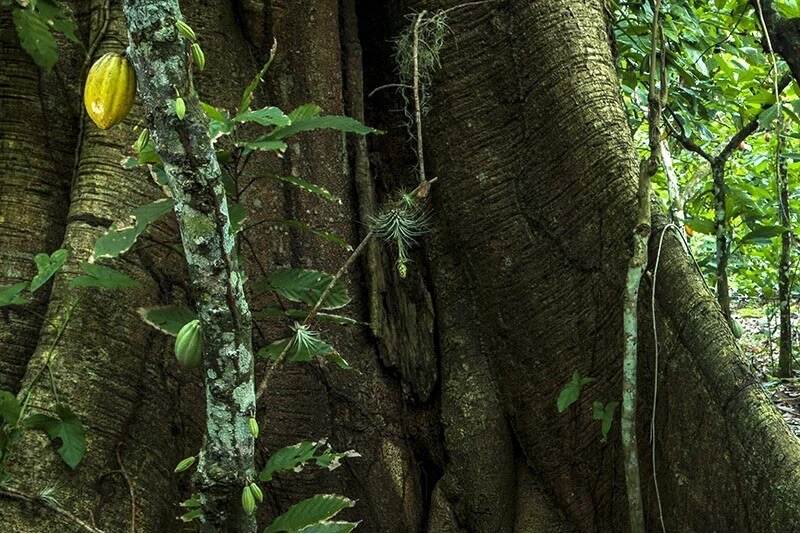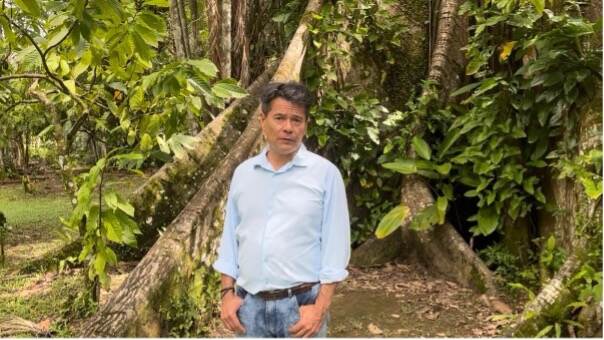Exploring Brazil's cabruca agroforestry
Nature-inclusive agriculture in the Netherlands is frequently associated with flower- and herb-rich grassland. But in the humid tropics, this farming approach focuses on incorporating trees that provide important environmental benefits. The traditional Brazilian cabruca system, for example, is a planting practice that provides higher resistance to phytosanitary outbreaks and makes crops more resilient to climate change.

The concept of nature-inclusive agriculture is not very well known in Brazil. When approached for comment on this topic, the Brazilian Ministry of Agriculture and Livestock MAPA stated that ‘We can report that it is conceptually little known and consequently not much used in Brazil. The concept of ‘inclusive in nature’ seems to be even less known and understood because ‘inclusive’ is mainly related to social inclusion.’ However, combining nature with crop production in order to preserve forests is quite common in Brazil.

Cocoa trees alongside other tree species
Examples include the cabruca agroforestry system, which involves planting cocoa trees (Theobroma cacao) alongside at least 20 native or exotic tree species. By planting high yielding cacao varieties in the shade of thinned-out or degraded forests, cabruca contributes to the restoration of the original vegetation, because Theobroma species, including cocoa, are native to Brazilian forests.
The cabruca system was developed centuries ago, in the southern part of the Brazilian state of Bahia, in the Atlantic Forest Biome. But in the early nineteen-hundreds, it was gradually replaced by unshaded cocoa monocultures. In the 1990’s, a fungal outbreak known as witches broom (Moniliopthora perniciosa) devastated the cacao plantations in the South of Bahia. In the wake of this outbreak, many monoculture plantations in the South of Bahia were abandoned and invaded by native species, effectively turning into cabruca systems.
This paved the way for land reform. In 2007, a group of 40 poor families occupied an abandoned cacao plantation in the municipality of Dois Riachões (BA). After some time, the plantation was given to them by INCRA, the Brazilian Institute for Colonization and Land Reform. The families started to work with the cabruca system. Today, the 400+ hectare settlement is managed collectively by all 150 community members, selling top-quality cacao to major chocolate brands.

Phytosanitary resistance and resilient crops
Recent studies suggest that the cabruca system offers benefits beyond nature-inclusion. Compared to monocultures, cabruca provides higher resistance to phytosanitary outbreaks and makes crops more resilient to climate change. Furthermore, the Atlantic Forest Research Institute (IPEMA) reports that the cabruca system currently conserves more than 278 native species of the Atlantic Forest Biome, of which 22 are threatened with extinction.
Yet, the Brazilian Forest Code of 2012 forbids new cabruca plantations in forested areas. Although the ecological services provided by this system are recognized by law, new agroforestry production units - including cabruca - can only be introduced in areas where the original vegetation has already been cleared for other uses: for instance, the traditional slash-and-burn areas of indigenous populations.
’The cabruca system currently conserves more than 278 native species of the Atlantic Forest Biome’
Ancient practice, profitable livelihood
There, Theobroma species such as cupuaçu (T. grandiflorum) are planted together with other crops. Many useful native plant species subsequently start growing on these clearings as the forest gradually retakes the lost ground over a period of 2 to 3 years. According to a leading botanist, this practice of enriching the forest under shifting cultivation has strongly shaped the current botanical composition of Amazon forests. These so-called new forests or cultural forests are supposedly more divers than the original vegetation.
No matter how you call it, combining nature with crop production certainly looks very promising for sustainable agriculture in Brazil. The challenge will be to transform this ancient practice into a profitable livelihood.
The Netherlands is by far the largest importer of cocoa beans in the world. Most of this is sourced from Africa. Maybe it’s time to import some nature-inclusive cacao from Brazil as well.
Contact
Would you like to know more about the current developments in the domain of agriculture and nature in Brazil or contact the agricultural team at the Netherlands Embassy in Brasilia or the Netherlands Consulate-General in Sao Paulo?
You can visit the country page of Brazil at the website agroberichtenbuitenland.nl of the Netherlands ministry of Agriculture, Nature and Food Quality. You can also send an email to BRA-lnv@minbuza.nl
This article is part of the latest edition of e-magazine Agrospecial (June 2023) about nature-inclusive farming. The teams of our Netherlands Agricultural Network showcase nature-inclusive practices and initiatives in 36 countries worldwide. They delve into the development, benefits and challenges of this innovative farming approach. Each team has a different story to tell. Click here to read more about insights into the potential of nature-inclusive farming practices worldwide!
References
- BALÉE, W. (2008) Sobre a Indigeneidade das Paisagens. Revista de Arqueologia, 21 (2):09- 23.
- GUIMARÃES, , E. A. M. (2017) Agrossivicultura São Cosme e Damião. Universidade do Estado da Bahia - UEB
- GUIMARÃES, E. A. M. (2014) Ciência, técnica e tecnologia: Vassoura de Bruxa, Cacau Cabruca e a ideia de progresso no Sul da Bahia. Anais Eletrônicos do 14º SNHCT. Universidade Federal de Minas Gerais – UFMG
- MOLL, P. (2021) Agroforestry and land reform give Brazil cacao farmers sweet taste of success. Mongabay Conservation News, Feb. 11, 2021.